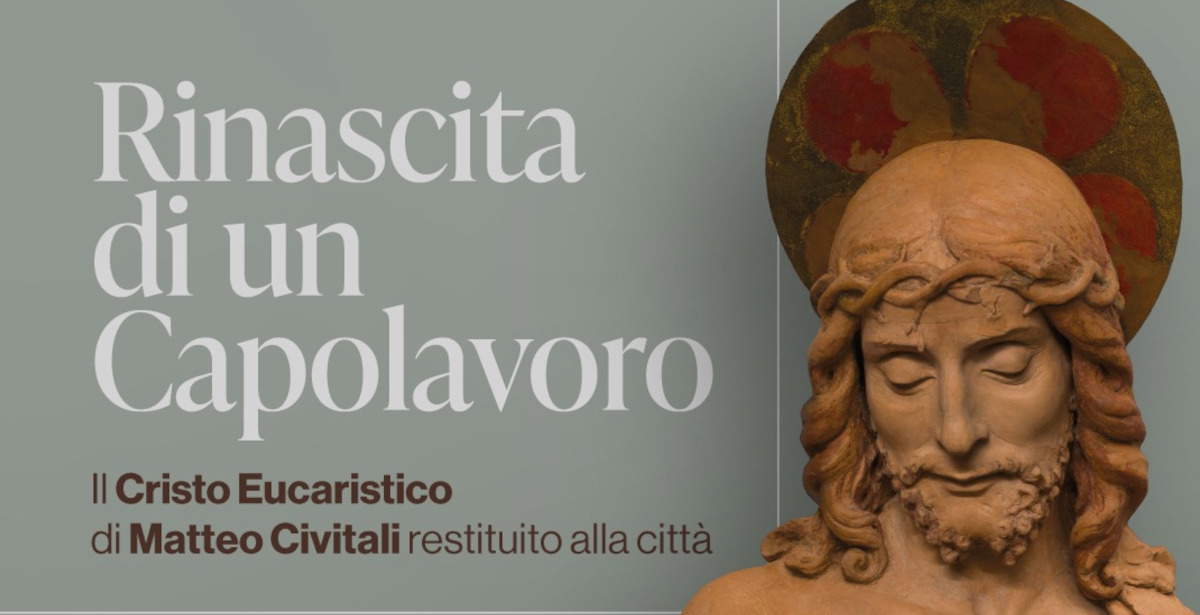The Villa Guinigi National Museum in Lucca presents from June 5 to November 2, 2025 the exhibition-dossier Rebirth of a Masterpiece. Matteo Civitali’s Eucharistic Christ returned to the city, in which the protagonist is precisely Matteo Civitali’s sculpture of the Eucharistic Christ, made in about 1470 in polychrome terracotta, which has just been restored. In fact, the intervention that began last February has been completed, and now the work is back on display in the museum. The exhibition-dossier is therefore an opportunity to admire the restored masterpiece but also to recount the restoration of the work itself in every detail, including through a documentary that filmed all the delicate stages of the intervention.
The Eucharistic Christ by Matteo Civitali has had a very troubled history: preserved for centuries inside the Church of Santa Maria della Rosa in Lucca, the sculpture was stolen by Nazi soldiers between February 7 and 8, 1944, and divided into two parts in order to transport it more easily. It ended up on the antiques market and was recovered by the Carabinieri of the Cultural Heritage Protection Unit in November 2017, after more than two decades of research, and transferred to the Villa Guinigi National Museum (formerly part of the Museums of Tuscany Regional Directorate of the Ministry of Culture and now part of the new Autonomous Institute of National Museums of Lucca), the museum that since the 19th century has brought together and exhibited the most important archaeological and historical-artistic evidence from the city and beyond.
The restoration of the work was made possible by the Rotary Club of Lucca, founded on March 17, 1935, in agreement with the Archiepiscopal Curia of Lucca, the Soprintendenza Archeologia Belle Arti Paesaggio of the provinces of Lucca and Massa Carrara, and the National Museum of Villa Guinigi, thus returning a masterpiece of the Lucca Renaissance to its city. The work, conducted by Carolina Cannizzaro and Massimo Moretti, with the scientific direction of the Soprintendenza A.B.A.P. of the Provinces of Lucca and Massa Carrara, was carried out in the laboratory of the Villa Guinigi National Museum to allow the assigned workers to work with greater safety and comfort.
Until the 1930s, the work had remained intact even though it had been heavily repainted over the previous centuries. It was as a result of being stolen in 1944 at the hands of Nazi troops that it suffered a deterioration in the conservation condition of both the ceramic body and the original pictorial finishes. After losing track of it for some 37 years, the work reappeared on the Florence antiques market in 1981, severely compromised by a brutal removal of the polychromy. A median cut divides it into two sections; also noted is the loss of the left index finger and part of the blood flow as well as fractures on the halo and neck. After it was found by the Nucleo dei Carabinieri per la Tutela del Patrimonio Storico-Artistico di Firenze in 2017, the work was very dirty and weighed down by an extremely shiny and yellowed varnish.
The restoration intervention restored to the work its structural integrity and a textural and chromatic legibility of the plastic surface and the residual pictorial finishes; it also reassembled the two pieces of the ceramic body, with the correct disassembly and reassembly of the poorly glued fragments. The lost parts were not reconstructed. As for the surviving pictorial finishes, the heavy glossy paint was completely removed and the repainting lightened. The retouching involved a partial integration of the disturbing gaps present within the surviving areas of pictorial film, attempting to tidy up the widespread abrasions present with a pictorial retouching performed “a puntinato.” The final protection was modulated in different concentrations of mat varnish depending on whether the terracotta or polychrome was involved.
The Eucharistic Christ is now displayed on a stainless steel structure that forms a suitable support and back support, previously prepared for the sculpture for the 2023 exhibition at the Scuderie del Quirinale entitled Arte Liberata 1937 - 1947. Masterpieces Saved from the War.
 |
| Matteo Civitali's Eucharistic Christ restored, now featured in a dossier exhibition in Lucca |
Warning: the translation into English of the original Italian article was created using automatic tools. We undertake to review all articles, but we do not guarantee the total absence of inaccuracies in the translation due to the program. You can find the original by clicking on the ITA button. If you find any mistake,please contact us.